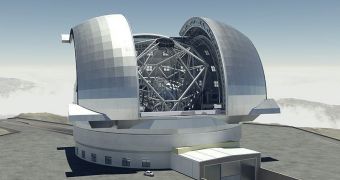Officials at the European Southern Observatory (ESO) announced yesterday that the largest observatory to be built in the world for the foreseeable future, the European Extremely Large Telescope (E-ELT), would most likely be hosted by Chile. The decision comes as no surprise, given the fact that ESO already has three observatories in the South American country, the ones at Cerro Paranal, La Silla and Llano de Chajnantor. Most analysts expected the new instrument to follow suit. The officials said that the Cerro Armazones location, in northern Chile, was most likely the final location of their new instrument, ScienceNow reports.
Deciding on a final location for the telescope was not by far an easy effort. Investigators spent more than 4 years on the road, looking at prospective sites, and analyzing weather patterns and possible sources of interference with future scientific observations. The location of a ground-based telescope is absolutely fundamental to the results it will return. If the location is poorly-selected, an international, multi-million-euro project could be useless. The analysis team looked at five primary building sites, of which four were located in Chile, and one in La Palma, a Spanish island also hosting observatories. The team presented its conclusions yesterday, at the ESO Headquarters, in Garching, Germany.
The site selection advisory committee showcased the pros and cons of all construction locations with the ESO council, and Cerro Armazones was selected for one very simple reason. The site is located relatively close to the Cerro Paranal observatory, which means that that E-ELT and the facilities at Paranal could in the future be operated in an integrated manner. There is still some uncertainty in the air however, as to whether the Chile location will indeed be selected. A final decision will be taken in June, when the full ESO council meets. There are political and social implications to the decision as well, and Spain has been campaigning massively to have the E-ELT built at La Palma.
Regardless of the site that will house it, the telescope promises to provide astronomers and astrophysicists with a wealth of new knowledge on the Universe. It will be the product of the combined effort of 15 countries, and will cost ESO member nations an estimated 800 million euros (roughly $1 billion) to build. It will feature a large, primary mirror with a diameter of 42 meters (140 feet), the largest ever built. Its main goal is to allow scientists to investigate exoplanetary atmospheres directly from ground-level.

 14 DAY TRIAL //
14 DAY TRIAL //